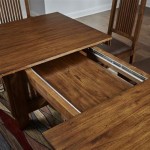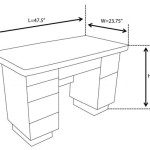Standard Study Table Length: Considerations for Optimal Study Space
A well-designed study table plays a crucial role in fostering an effective and comfortable learning environment. While personal preferences influence individual needs, understanding the standard study table length is essential for creating a workspace that promotes focus, productivity, and ergonomic comfort. This article delves into the key factors influencing standard study table length, exploring the considerations for optimal study space and providing guidance for choosing the right size.
Factors Determining Standard Study Table Length
The ideal study table length depends on various factors, including the individual's height, the type of tasks they perform, and available space.
Height: A comfortable study table should allow the user to sit with their elbows bent at a 90-degree angle and their feet resting flat on the floor. This promotes good posture and reduces strain on the back, neck, and shoulders. The standard study table height of 29 inches (73.7 cm) is generally suitable for most adults. However, individuals taller or shorter than average may need to adjust the height accordingly.
Task Requirements: The type of tasks performed on the study table also influences its length. Students studying with laptops or textbooks may require a shorter table, while those working with large engineering projects may find a longer table more suitable.
Available Space: The available space in the room significantly impacts the study table's length. A small room may necessitate a compact table, while a larger room allows for a more expansive workspace.
Standard Study Table Length Recommendations
Based on the factors discussed above, here are some general recommendations for standard study table length:
Single User: For a single individual, a study table with a length of 4 feet (120 cm) is generally considered suitable. This provides ample space for a laptop, books, and other essential study materials. A 5-foot (150 cm) table offers additional workspace and flexibility, particularly for those who prefer more room for spreading out their materials.
Multiple Users: For two or more users, a study table with a length of 6 feet (180 cm) or longer is recommended. This allows for adequate space for each person to have their own workspace without feeling cramped.
Ergonomic Considerations for Study Table Length
Beyond the standard length, ergonomic factors play a crucial role in optimizing study space for comfort and productivity.
Depth: The depth of the study table is equally important as its length. A depth of 24 inches (61 cm) is generally recommended to provide sufficient space for working comfortably and preventing posture problems.
Chair Choice: The choice of chair significantly influences the overall comfort and ergonomics of the study table. A chair with adjustable height and lumbar support is highly recommended. It should allow the user to maintain a neutral spine and proper posture while seated.
Lighting: Adequate lighting is essential for comfortable and effective studying. A well-lit workspace reduces eye strain and fatigue. Natural light is ideal, but a combination of overhead and desk lamps may be necessary for optimal illumination.

Otieno Study Console Table Office Room Furniture Singapore Sg Bedandbasics
What The Typical Height Of An Office Desk Quora

Result For Executive Table Dimension Office Design Desk Dimensions Furniture Standard
Standard Office Study Table Dimensions In Malaysia Which Desk Size Is Best For Your Workspace Cuura Space

Mobilya Düzenleme Çalışma Masaları

Study Table Dimensions Free Dwg Layakarchitect

This Is Why Desk Height Matters For Your Posture Arteil

Office Desk Size Digihome Designs Computer Design Table

Desk Height Calculator Office Ergonomics In A Blink

Standard Sizes For Various Types Of Furniture Engineering Discoveries Kids Table And Chairs








